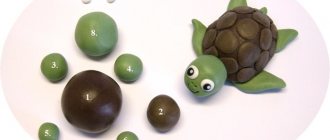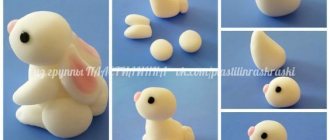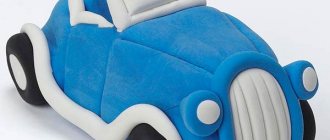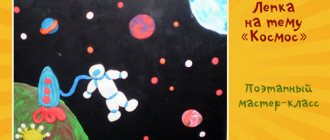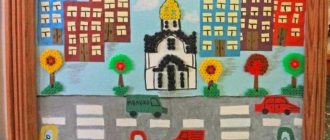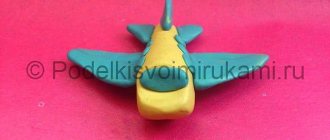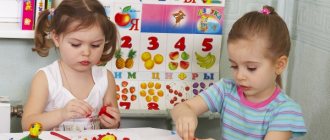In this article you will find many ideas for modeling from plasticine with step-by-step instructions and photos, as well as what crafts you can do with a child at different ages.
Working with plasticine has a beneficial effect on a child's development. These activities improve memory, attention, have a good effect on thinking, develop fine motor skills of the hands, which in turn contributes to the development of speech, form the imagination, open up creative abilities, and force one to exercise imagination. You will learn more about the benefits of practicing with plasticine and other materials in the article Let’s sculpt with children from plasticine. Plasticineography
Is plasticine necessary for children under one year old?
It is recommended that children engage in modeling from the age of 1; until the child is one year old, the child will most likely show no other interest in plasticine other than trying it out. But children are all different, so you can try modeling with your child earlier. Show your baby plasticine of one color, tear off a piece of it, roll the ball, let him hold it in his hands. If the child is not interested, put it aside and try again after a while.
For small children, it is best to use soft plasticine, for example, or better yet, prepare your own salt dough. Read about salt dough and crafts made from it in the article DIY salt dough crafts. Crafts for the holidays
What you need for the craft
The materials and tools needed for making crafts with 1st grade students differ little from those needed for other age groups:
- Plasticine.
- Work board or mat.
- Stacks.
- Paper scissors.
- Rolling pin.
- Molds for repeated production of flat shapes.
- Apron and sleeves.
There are many varieties of plasticine suitable for modeling with children 6-7 years old.
Important! Particular attention should be paid to the composition. The material must not contain substances hazardous to the body.
| A variety of plasticine | What kind of work is it suitable for? | pros | Minuses |
| Paraffin | for most jobs, this type of plasticine is most often used in modeling classes | affordable price, easy to find in stores, made from natural ingredients | quite hard, stains clothes and hands |
| Floating | — | stays on the surface of the water, soft, does not stick, does not stain hands | price |
| Wax | — | soft, flexible, easy to mix different colors, does not stick, easily washed off hands and clothes | price |
| Solidifying | ideal for crafts | plastic, suitable for sculpting figures and figurines that are preserved for a long time | price, not suitable for repeated modeling, hardens quickly |
| Ball | — | does not stick to hands and clothes, large palette of colors, easy to mix with each other | price |
| "Smart" | — | Has different consistencies, stretches easily, tears, can be magnetized, pliable | price |
Stacks are used for cutting plasticine or giving relief. They can be made of wood or plastic. Plastic ones are considered the most convenient and safe for children of any age, including first-graders.
Scissors are used to cut plasticine into pieces when a more even and clear cut is needed, which a stack cannot provide. A rolling pin is needed for rolling out layers. There is a special small rolling pin on sale.
Modeling from plasticine for children 2 and 3 years old
At the age of 2 to 3 years, a child still cannot cope with ordinary plasticine, so it is worth choosing special soft plasticine for small children.
Children are still learning to control their hands and it is difficult for them to practice modeling. Select tasks that are not difficult for your child so that he can cope with them; this will inspire him, give him self-confidence and he will want to continue to engage in this useful type of creativity.
By the age of three, a child will already be able to:
- tear off pieces from plasticine
- make balls out of them
- flatten them
- stick plasticine to paper and smear it
- crush the balls with your palms
- make sausages
- twist them into rings
- combine all the components into one craft.
The parents' task is to teach their child this.
Show your child
- how to cut a sausage and get rings
- how to cut out figures from flat cake
- how to cut dough into squares, triangles and other shapes
- how to stick various objects onto plasticine smeared on cardboard, for example, seeds, beads, cereals, pasta
The duration of a modeling lesson at the age of 1-3 years is 5-15 minutes and depends on the child’s mood and desire to work with plasticine.
For this age, it is recommended to use plasticine only in primary colors, so as not to overload the child with a large variety and not distract from the modeling activity itself. In addition, if desired, colors can be mixed and new shades can be obtained.
Flat and volumetric applique
Three-dimensional pictures on cardboard are created from molded parts, flagella and mosaics. The background is drawn with pencils, watercolors or made from plasticine using the smearing technique.
The most interesting topics for children are: “Birds and Animals”, “Nature”, “Based on Fairy Tales” and “Underwater World”.
Modeling from plasticine for children 4 and 5 years old
At the age of 4-5 years, a child already skillfully handles a modeling knife, his hands are already stronger and he can work with ordinary plasticine.
Children of this age know how to roll balls and sausages, and now it will be more interesting for them to make more complex and interesting crafts themselves.
Invite your child to make a mushroom meadow or forest lawn with bushes and trees around. Maybe the child will want to make something of his own, don’t interfere with this. On the contrary, this is good and fosters independence.
Also, the mother can sculpt one part of the composition, and the child another, then combine everything into one craft. This way the child will feel responsible for his part of the work.
A child at this age can sculpt simple figures of animals, plants, birds, and food for dolls.
You can begin to master the technique of plasticine printing with your child and make simple plasticine paintings and panels. Invite your child to add natural and waste materials to such paintings.
The time of working with plasticine is 10-20 minutes; if the child is very enthusiastic, it can be extended a little, depending on the child’s perseverance.
Materials and tools for modeling
In addition to the spatula, it is worth thinking about preparing the workplace.
Suitable working surface:
- Special board;
- Oilcloth;
- Sheet of cardboard;
- Kitchen cutting board.
Some natural and artificial materials may also be useful, such as:
- Cones;
- Nuts;
- Pebbles;
- Beads;
- Rhinestones, etc., it all depends on the intended product.
Modeling from plasticine for children 6 and 7 years old
You can use regular plasticine or buy different sets, for example, for modeling confectionery products. There are also kits with mass for modeling; they harden well in air and are preserved in the future.
At primary school age, children already know how to independently fantasize and bring their ideas to life. They sculpt more complex figures following step-by-step instructions.
Help your child make a picture from plasticine; he can already make more intricate drawings with a lot of small details, transitions of colors and different textures.
There is no need to limit the time for modeling at this age; let the child do as much as he wants and as much imagination and perseverance as he has.
Useful tips
Before you learn how to make a craft from plasticine, you need to familiarize yourself with some points. Useful tips will greatly help beginners in this exciting business.
- If you don't have a special board for modeling, you can use a piece of cardboard or something hard, wrapping it in cling film.
- Instead of a rolling pin, you can use a small bottle of warm water.
- A special knife can be replaced with a knife from a set of plastic utensils.
- Instead of stacks, you can take any available materials - caps, buttons, lids, rulers, etc.
- To create thin bundles, a regular syringe is suitable.
In addition, plasticine products can be decorated with various beads, buttons, colored sand and salt, cereals, and natural materials. The photo of plasticine crafts clearly shows how you can decorate the finished product.
How to make food for dolls from plasticine?
Soft plasticine is good for creating toy food. It will be boring for the baby to just make balls, but if they are used as decoration for a toy cake, it will be more interesting. You can make various cakes, pasta, sandwiches, pastries and much more with your child, as long as your imagination is enough. You don’t have to throw away the candy boxes, but make your own toy candies for them. Be sure to fit your doll food to the container they will eat it from.
For older children, you can combine the lesson with mathematics, divide the cake into equal parts and study fractions, feed guests and count how many cakes you need to prepare for them.
Below we give you several step-by-step instructions on how to make some food for dolls from plasticine.
Broccoli made from plasticine
Take plasticine in three different shades of green. From the lightest one, make a sausage leg for cabbage, divide it in a stack into several small branches. Take three pieces of plasticine of different shades and press them through a kitchen strainer, and you have broccoli florets. Connect these parts together.
Modeling sausages from plasticine
Prepare sausage-colored plasticine. Make a flat cake out of it, put white stripes on top. Roll the cake, roll it like a sausage between your palms and put it in the refrigerator for a while. You need to cut the sausage using sawing movements, not pushing.
Making ice cream from plasticine
Take a piece of sand-colored plasticine and stamp cells on it, like on waffles. Now make a cone and one or three balls, the same color as you want to make ice cream, you can take different colors. We stick the balls onto the cone to its base, and wrap it with our wafer cake. You can add jam on top by smearing two or three sausages crosswise on the balls, stick small multi-colored pieces and sprinkle with crumbs.
Modeling cheese from plasticine
The cheese is made from yellow plasticine with a small addition of orange. Make a cake, cut out a triangle and press holes in it, it is convenient to make large holes with the back of the pen, and small ones with a writing tip or pencil.
Making a cake from plasticine
Make several plasticine balls of different colors, it is better to take two brown ones for the chocolate layers of the sponge cake, two different berry colors and one of whatever color you want for the icing.
We make chocolate and berry cakes very simply, flatten the ball a little and roll it out into barrels to even them out.
We combine all the cakes into one cake and roll it sideways again to even out all the layers.
We take our icing ball and roll it out as thin as possible, wrap our entire cake in it, cut off the excess edges and smooth it out.
Now we make the cream: roll out the plasticine into a thin and long sausage, fold it in half and twist it. We spread it around the perimeter of our cake.
We cut the cake into pieces and use a toothpick or toothbrush to add porosity to our chocolate layers of the sponge cake. Each piece can also be decorated with fruit beads and topped with glaze.
Bread can be sculpted using sand-colored plasticine. To make a loaf, add toothpick prints to it diagonally.
How to make a watermelon from plasticine?
We take black plasticine and roll several thin sausages. We roll out the red plasticine into a not very thin oval-shaped cake. Place one sausage in the middle and fold the flatbread in half.
Add a couple more sausages and fold them again and repeat this several times. Finally, give it a round shape.
We wrap our watermelon in a white cake, and then in a green one, thus making a peel.
Add lighter colored green stripes.
And cut it. Look how ripe our watermelon turned out!
Turtle
Make a small plasticine craft with your child; with step-by-step instructions you will very quickly master the entire manufacturing process. A funny turtle will complement your collection of crafts.
How to sculpt:
- Prepare several circles of different sizes using a brown and green base.
- Use a brown circle to form a “shell” for our turtle.
- Flatten small circles from the brown base and attach them to the “shell”, forming a characteristic color for this animal.
- Sculpt legs and a head from a green base and attach to the prepared body.
- Make indentations on the muzzle where the eyes will be placed, draw a nose and mouth.
- Then attach the eyes too.
Modeling a bird from plasticine
Let's blind a parrot. Follow the step-by-step instructions below and you will have a beautiful and talkative bird.
- Take red, yellow, blue, white and black plasticine
- Make an oval body for a parrot from yellow plasticine
- Add a smaller red circle - this will be the head of our bird
- The wings will be blue, to do this, stick two droplets on the sides of the body
- Add a white breast to your parrot
- Make a yellow beak, stick on the eyes and make a crest from the cones
- Let's add another tail and use a stack to push through the grooves on the bird's chest and wings that resemble plumage
- All that remains is to attach the paws and the parrot is ready
This kind of cockerel can be made from plasticine.
This is how a penguin is made from plasticine.
Compositions for modeling with children in kindergarten on the theme of winter, autumn, spring
Modeling from plasticine for children 5-6 years old should contain compositions from different seasons. This allows children to learn, understand and remember the characteristics and differences of natural seasons.
Below are examples of autumn and winter compositions.
Composition “Autumn”
This master class will show you how to convey the mood and colors of late autumn:
- To depict a leaden sky, you need to mix dark and bright colors. To do this, we combine the following colors of plasticine: gray with black, yellow with purple, blue with black. You will also need a blue piece.
- Using our fingers, we begin to spread yellow-violet plasticine on the paper from the upper corner, and draw a blue stripe below.
- Above the blue color, smear a dirty yellow spot with your finger, stretching it in all directions like the meager rays of the sun.
- Fill the sky completely with a gray-black and blue-black mixture to represent looming clouds.
- Along the bottom of the sky, extend the blue stripe for contrast.
- For the ground, a mixture of brown, white and yellow plasticine is used. This mass must first be kneaded in your hands, then spread on the bottom of the cardboard.
- Completely fill the empty space with this mixture until the blue stripe appears.
- Sculpt dark brown branches and a flat tree trunk, as well as yellow and orange foliage.
- Stick branches and trunk as a tree on the left and a bush on the right. The branches should be inclined to the right, as if they were being bent by a strong wind.
- Stick yellow leaves on the branches and under the tree.
- Press down each leaf with a stack so that a stripe remains in the form of a vein.
- We add orange leaves to the bush, and also go over them in a stack.
- We sculpt additional details: brown stump, beige honey mushrooms, black birds.
- All of them are attached to the picture.
- Add rose hips to the bush.
The autumn composition is ready.
Composition “Bullfinch”
This master class on sculpting a bright three-dimensional composition of a bullfinch on a branch:
- Cover the cardboard with a thin layer of a mixture of white and blue or blue plasticine. Blue and white plasticine should not be mixed until completely homogeneous; it is necessary that marble stains and inclusions remain visible.
- Roll out a long sausage from a brown block, tapering towards one end and widening towards the other end.
- Prepare a lot of thin green threads from plasticine as spruce branch needles.
- Stick a brown branch approximately in the center of the picture, approximately diagonally.
- Next, fragments are torn off from the green threads, bent in half and attached to a branch as Christmas tree needles. This is the only long process in creating a composition.
- The entire branch must be filled with needles.
- You can add more branches below and above the main one, keeping in mind that the central part of the picture should be left for the bullfinch.
- To make a bird, you need to fashion 2 thick cakes: black for the body and red for the breast. Give them the desired shape.
- You will also need one gray wing with 4 thin white stripes.
- Fasten the torso to the chest and attach the wing to it.
- Attach a white eye circle with a black pupil and a triangular yellow beak to the head.
- Attach the bullfinch to the background above the branch.
- Make a brown foot and attach it to the bird and a spruce branch.
The winter composition is ready.
Modeling from plasticine is a good way for preschool children to usefully spend part of their free time.
Article design: Natalie Podolskaya
How to sculpt dinosaurs from plasticine?
- Take plasticine of any color, because you can make a dinosaur whatever you want
- Divide a piece of plasticine into three parts, one will go to the head, from the second we will sculpt the body, and the third will be divided into all other parts
- Divide one piece into three more parts, and one of them also into three
- From the two largest pieces we make the body and the head, to do this we roll them into sausages and stretch them out, connect them to each other and align the junction. What you should get is shown in diagram number 3
- Roll the two middle pieces into cylinders and stretch them out a little, flatten them from the bottom and top, leaving a thin “waist” - form the legs as shown in diagram 4
- Make sausages from small pieces - front legs
- Now assemble the figure from what is already ready and smooth out all the joints
- Roll a lot of small balls from the remaining piece of plasticine and stick them, pressing them on the sides, onto the dinosaur's crest.
- Make his eyes and don't forget about his eyelids
- Use a plasticine knife to cut the dinosaur's mouth and open it. Push down the nostrils with a toothpick, trim the paws a little
- Make teeth and claws for our figurine from white plasticine
You can also make such a dinosaur from a pine cone.
And here is another dinosaur - stegosaurus, one of the most popular among children.
If a child wants to make a predator dinosaur, invite him to make a Dimetrodon.
Plasticine painting from flagella
A subject or subject picture with plasticine flagella looks much more realistic than a simple applique. Thin sausages are rolled out from pieces between the palms or squeezed out using a syringe.
The second method is beyond the capabilities of younger preschoolers, so adults make such preparations themselves. And the children twist them into a spiral or snake and glue them onto cardboard.
Craft materials:
- Outline illustration from a coloring book. You can also draw your own design on cardboard by hand or using templates.
- Soft plasticine in the desired colors.
- Medical syringe with a volume of 5–10 ml.
- Container with hot water.
How to sculpt a pony from plasticine?
After watching the My little pony cartoon, your daughter will probably want to make the same pony. Let us help her with this.
- Take plasticine of the desired color, pink, purple, red and blue shades are perfect
- Roll a sausage of the chosen color - this will be the body of the pony
- Pull one side of the sausage up into a cone - this will be the neck
- Roll the ball and stretch it out a little, forming the face of a small horse
- Make droplets out of two small pieces and stick them to the top of the muzzle - these will be the ears
- Use a toothpick to press down the pony's nostrils and mouth.
- Roll four cones from plasticine of the main color, cut off a little plasticine diagonally from the narrow side with a special knife, this is where the legs will be attached to the body
- Tap the wide part of the cones on the board to create horse hooves
- Assemble your figurine. Smooth out the joints
- To make the mane and tail, roll several thin multi-colored sausages, connect them together and cut them, stick them to our pony, bend them a little, imitating the curves
- Don’t forget about the eyes, make them not round, but elongated, in the shape of a leaf
Our pony is ready!
You can make several small horses of different colors and you will have many cartoon characters to play with.
You can make a pony in another way, see step-by-step photos below.
Master class: hedgehog
Making children's crafts from plasticine is very interesting; you can try making a cute hedgehog.
- You need to mold a small ball from brown plasticine, then the ball needs to be shaped like a drop, this will be the body of a hedgehog.
- White and black plasticine is used to sculpt the mouth, nose and eyes.
- You need to insert sunflower seeds into the hedgehog's back, sharp edges up, these will be its needles.
- If desired, you can make a mushroom and an apple, which can be attached to needles.
This is a very simple craft that any child can do.
Crafts from plasticine
Show your imagination and combine natural materials and plasticine in one craft. It will be unusual and interesting for the child.
Making a boat from plasticine and nutshells
- Prepare nut shells, plasticine, leaves from trees, small sticks
- Stick a ball of plasticine into a cleaned shell and place a mast on it - a small stick
- Place leaf sails on the mast and attach another plasticine ball on top
- Launch your boats into the water
Making a caterpillar from plasticine and chestnuts
- Cook some chestnuts
- Roll several colorful plasticine balls
- Connect the chestnuts, alternating them with plasticine, press them down so that they stick firmly
- Make eyes from white and black plasticine
- Add a red balloon nose and a sausage mouth
- Don’t forget about the horns, they can be made from pieces of a match, combined with plasticine with chestnuts
You can also make a hedgehog like this from chestnut peel and plasticine.
These are such cheerful multi-colored snails made of plasticine and chestnuts.
Master class: donut
All children love sweets, which is why you can try making a delicious donut.
- You need to take yellow plasticine and roll a small ball out of it.
- The ball needs to be flattened and a small hole made in the center; you can use improvised materials
- A flat pink cake with uneven edges is made from pink plasticine, which is placed on top of the donut.
- Be sure to poke a hole in the pink pastry in the very center of the donut.
- From different colors of plasticine you need to roll up bright thin flagella, which are glued on top of the pink glaze. The donut is ready!
